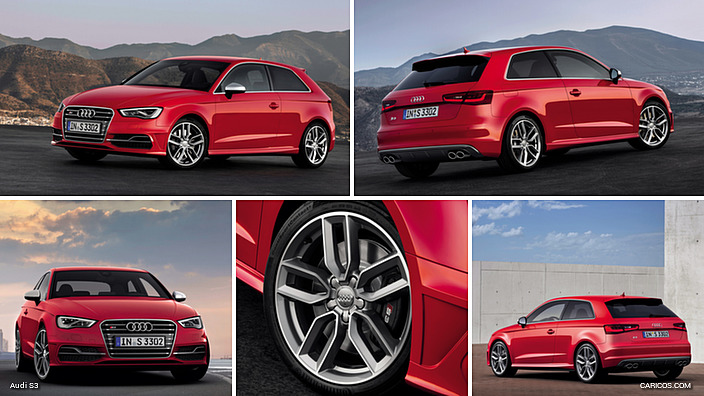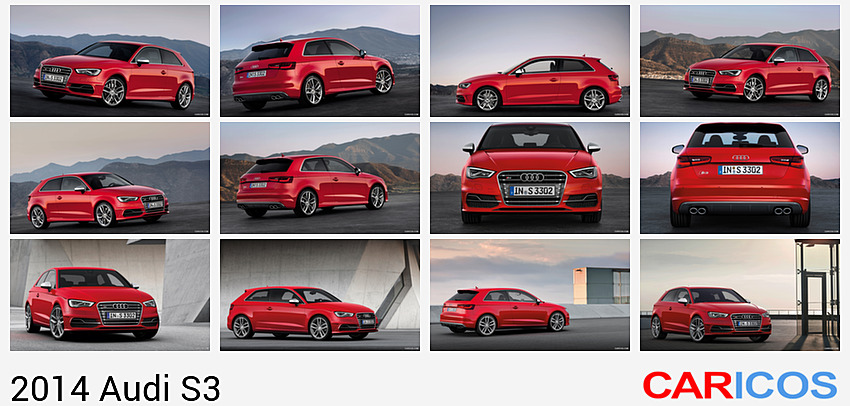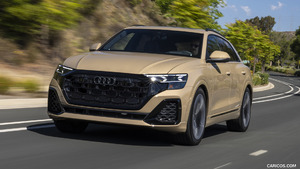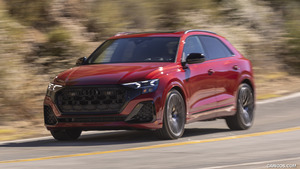Audi S3
Engine
The long-stroke 2.0 TFSI in the Audi S3 has been developed from scratch. The only thing it has in common with its predecessor, which was named Engine of the Year five times in a row between 2005 and 2009, is its displacement of 1,984 cc (bore x stroke 82.5 x 92.8 millimeters [3.25 x 3.65 in]). The four-cylinder unit delivers a constant 380 Nm (280.27 lb-ft) of torque to the crankshaft between 1,800 and 5,500 rpm. Rated power at 5,500 rpm is 221 kW (300 hp), and the engine redlines at 6,800 rpm.
The S3 delivers impressive performance. The sprint from zero to 100 km/h (62.14 mph) is completed in 5.1 seconds when equipped with the S tronic (5.4 seconds with the manual transmission). The electronically governed top speed of 250 km/h (155.34 mph) is just a formality. The S3 with S tronic consumes on average just 6.9 liters of fuel per 100 km (manual: 7.0 liters) [34.09 and 33.60 US mpg]. This corresponds to CO2 emissions 159 (162) grams per kilometer (255.89 and 260.17 g/mile) and for models equipped with the manual transmission, an improvement of 1.5 liters compared with the previous version.
The powerful four-cylinder engine features two balance shafts rotating at twice the speed of the crankshaft for tremendous smoothness. The sound is emotion-inspiring and sporty. An electromechanical sound actuator at the bulkhead brings the engine sound to life in the cabin. The exhaust system also includes a sound flap that opens at certain engine speed ranges to give the S3 a sportily sonorous sound.
The 2.0 TFSI boasts groundbreaking solutions in many fields of technology. One of these is the additional use of indirect injection. It supplements the FSI gasoline direct injection at part load to reduce consumption and particulate emissions. FSI injection, which works at pressures up to 200 bar, is used when starting and at higher loads.
 2014 Audi S3
2014 Audi S3
The developers achieved new degrees of freedom when it comes to filling the combustion chambers. On the exhaust side, the Audi valvelift system varies the stroke of the valves in two stages; the camshaft on the intake side can be adjusted steplessly through 30 degrees of crankshaft angle while 60 degrees of adjustment is available on the exhaust side. The compression ratio of 9.3:1 is unusually high for a turbocharged engine.
The exhaust manifold is integrated into the cylinder head, where it is bathed in coolant. This solution lowers the temperature of the exhaust and accelerates warmup following a cold start, which lowers consumption during the cold-start phase. This concept also has a positive effect on fuel consumption during sporty driving because full-load enrichment is no longer necessary. The large turbocharger is also a new development. It achieves a maximum boost pressure of up to 1.2 bar for even more spontaneous engine response. A high-performance intercooler integrated into the water circuit greatly reduces the temperature of the compressed air and thus increases the amount of air required for combustion.
With the 2.0 TFSI’s innovative thermal management system, two rotary slide valves consolidated in a single module regulate the flow of coolant. These valves ensure that the engine oil heats up to its operating temperature soon after the vehicle is started; they also maintain the coolant temperature, as per a given driving situation, between 85 and 107 degrees Celsius (185.0° F and 224.6° F). As a result – regardless of load or engine speed – the valves always strike the perfect balance between minimal friction and high thermodynamic efficiency.
The 2.0 TFSI has been designed specifically for use in the new Audi S3. Pistons with stronger bolts and new rings plus reinforced connecting rods with new mounts transfer the power to the crankshaft. The gray cast iron crankcase has been reinforced at the main bearing seats and the main bearing cover. The cylinder head is made of a new, particularly lightweight aluminum-silicon alloy characterized by high strength and temperature resistance.
An innovative coating on the piston skirts and mounting the balance shafts in roller bearings keep internal friction low. The regulated oil pump only consumes as much energy as is necessary for the current driving situation.
Despite its complexity and the high performance, the new 2.0 TFSI weighs just 148 kilograms (326.28 lb) – more than five kilograms (11.02 lb) less than the previous engine. The dimensions are compact: 603 millimeters (23.74 in) long, 678 millimeters (26.29 in) wide and 664 millimeters (26.14 in) high.
Transmissions
The new Audi S3 comes standard with a manual six-speed transmission with a lightweight magnesium case. The optional S tronic boasts high efficiency and a tall sixth gear. The lower gears are short in the interest of dynamics, as is also the case with the manual transmission.
The S tronic comprises two subunits, with two multi-plate clutches controlling the gears. The large K1 clutch located on the outside directs the torque via a solid shaft to the gear wheels for gears 1, 3 and 5. A hollow shaft rotates around the solid shaft. It is connected to the smaller K2 clutch, which is integrated inside its larger sibling, and which acts on the gear wheels for gears 2, 4 and 6, as well as reverse.
Both transmission structures are continuously active, but only one of them is connected to the engine at any one time. For example, when the driver accelerates in third gear, the fourth gear is already engaged in the second transmission section. Shifts are performed by switching the clutches. This takes just a few hundredths of a second and happens so quickly and smoothly that it is barely perceptible.
S tronic can be operated using the short selector lever or with the optional paddles on the steering wheel. It includes the modes D and S in addition to manual mode. The driver can activate launch control at the push of a button. This manages starts with controlled tire slip to deliver maximum engine power to the road.
quattro permanent all-wheel drive is an integral component of the powertrain. It gives the new top model in the A3 series a decisive edge over its two-wheel-drive competition. The Audi S3 can accelerate earlier and more safely when exiting a corner. It remains dynamic and stable under all conditions, particularly in the rain and snow.
The heart of the quattro drive system is an electronically controlled and hydraulically actuated multi-plate clutch. In the interest of balance axle load distribution, it is located at the end of the prop shaft, in front of the rear axle differential.
Inside is a package of plates that rotate in an oil bath. The metal friction rings are arranged behind one another in pairs – one ring of each pair is rigidly meshed with the housing, which rotates with the prop shaft; the other ring is meshed with the output shaft to the rear axle differential.
During normal driving, the clutch sends most of the engine’s power to the front wheels. If traction decreases there, the clutch can transfer torque steplessly to the rear axle in just a few milliseconds by forcing the packages of plates together via controlled action. An axial piston pump generates the necessary pressure almost instantaneously.
Chassis
The new Audi S3 offers the dynamic driving characteristics of a sports car. It responds to steering input precisely and spontaneously, and takes all types of corners at high speed and with little body movement. Its handling is precise, safe and virtually neutral.
One reason for this performance is the finely balanced distribution of the axle loads. The front axle has been shifted forward 52 millimeters (2.05 in) compared with the previous model. The new 2.0 TFSI is 5 kilograms (11.02 lb) lighter than the previous engine and is installed tilted backward by 12 degrees. This layout is a result of the Group’s modular transverse platform, on which the new Audi S3 is based.
The subframe, the pivot bearings in the McPherson front axle, the crash management system, the front fenders and the engine hood are made of aluminum. All together they save 17 kilograms (37.48 lb) of weight. The front wheel suspension has a track width of 1,535 millimeters (60.43 in). A stabilizer bar is used front and rear.
Another innovation in the Audi S3 is progressive steering. The steering rack is geared in such a way that the ratio varies. It is somewhat more indirect around the center and very direct when steered sharply. For the driver, this technology combines a pleasantly smooth character when driving straight ahead with highly spontaneous response in tight corners.
The powerful electric motor providing the servo boost harmonizes perfectly with the character of the steering system, decreasing its output as speed increases. It consumes no energy when driving straight ahead and thus reduces fuel consumption by as much as 0.3 liters per 100 kilometers. The progressive steering works closely together with various systems on board the new S3, such as the standard rest recommendation and the optional Audi active lane assist and park assist systems.
The four-link rear suspension has a track width of 1,511 millimeters (59.49 in). Its sword-shaped trailing links absorb the propulsion and braking forces. Their bearings are large and relatively elastic in the interest of a more comfortable ride. On the other hand, the three wishbones per wheel for absorbing lateral forces are attached very rigidly to the steel subframe for improved handling. All of the bearings are sportily taut compared with the A3.
The links of the rear axle are made of high-strength steels; the wheel carriers are aluminum. The shock absorbers and the compact coil springs are separate from one another, resulting in sensitive response and a high luggage capacity. The sport suspension lowers the body by 25 millimeters (0.98 in) compared with the A3.
The new Audi S3 rolls on 7.5 J x 18 alloy wheels with 225/40-series tires. The wheels sport an S-specific design with five parallel spokes. They are produced using sophisticated flow forming technology, in which the outer rim is rolled out over a cylinder at high pressure and high temperature. While the system is shaping the wheel blank it is also strengthening the material, which allows for thinner wall thicknesses – the wheel is lighter, yet stronger. Despite their dynamic performance, the tires also feature low rolling resistance and thus contribute to the efficiency of the Audi S3.
The brakes of the new S3 can be very precisely metered. The pedal feel is spontaneous and firm. The front discs are internally vented and measure 340 millimeters (13.39 in) in diameter. The black brake calipers are emblazoned with S3 logos. The new electromechanical parking brake, which the driver operates via a button, is integrated into the rear axle brake system. The latest evolution of the ESC electronic stabilization control intercedes very precisely. Audi drive select comes standard in the new Audi S3. It incorporates the characteristics of the electronic accelerator, the boost of the progressive steering and the shift points of the optional S tronic. The driver determines with the push of a button whether these systems operate in comfort, auto, dynamic, efficiency or individual mode. In individual mode (available with the MMI radio or above), drivers can compose their own preferred profile within certain limits.
In efficiency mode, the function of the standard deluxe automatic air conditioning, the cruise control or adaptive cruise control and the adaptive light is modified for optimal fuel consumption. In this case, the S tronic switches to coasting mode when the driver takes his or her foot off the gas pedal. Another optional module integrated into Audi drive select is the electromagnetic damper control system Audi magnetic ride. A synthetic hydrocarbon oil containing microscopically small magnetic particles circulates within the damper pistons. When a coil applies a voltage, the particles align perpendicular to the direction of flow of the oil, impeding its flow through the channels in the pistons.
The control unit constantly analyzes the condition of the road and the driver’s style, repeatedly adapting the damper forces within milliseconds. The driver can choose between three modes. The new S3 is balanced in normal mode and tightly connected to the road in sport mode. Steering response becomes even more spontaneous, and yaw movements are largely suppressed.
Body
Ultra lightweight construction is an Audi core competence. The new S3 weighs no more than 1,395 kilograms (3,075.45 lb), a value that is easily the best in its competitive environment. Compared with the previous model, curb weight has been reduced by 60 kilograms (132.28 lb). Thanks to hot-shaped, high-tech steels, the body-in-white alone represents a weight saving of 28 kilograms (61.73 lb) over the previous model. The large aluminum parts in the front section of the car round out the lightweight construction concept.
The three-door body of the S3 is also very stiff, crash-safe and quiet. A noise-insulating windshield is standard. The coefficient of drag is just 0.33. The new Audi S3 is 4,254 millimeters (13.96 ft) long, 1,777 millimeters (5.83 ft) wide and 1,435 millimeters (4.71 ft) tall. Its wheelbase measures 2,595 millimeters (8.51 ft), 17 millimeters (0.67 in) more than its predecessor.
Exterior design
The new Audi S3 has a firm and sporty road stance. Each element of the design is precise and distinctive. The athletic sculpture with the low engine hood, the characteristic tornado line below the windows and the sharply sloped C-pillars stretch the body visually. Audi supplies xenon plus headlights with LED daytime running lights as standard. The flat rear lights, into which the adaptive brake light is integrated, are also fitted with light-emitting diodes. The xenon-based Audi adaptive light swivels into curves. It is also linked to the navigation system and can be upgraded with special lighting functions of urban, interurban and highway driving, as well as for intersections and tourist attractions. When combined with the front-facing camera, the light-dark boundary of the headlights is automatically and steplessly adjusted for substantially improved visibility and safety.
A true first in the premium compact class are the optional LED headlights, which previously have only been available in full-size models. The low beams are generated in two free-form reflectors with a total of nine high-performance LED chips. Ten high-performance LEDs in the matt aluminum trim provide the high beams. Depending on the features chosen, the high beams are switched on automatically and LED cornering lights illuminate tight corners. Interurban, highway and tourist attraction lighting round out the lighting convenience functions. The all-weather lights enhance safety in fog or snow.
The Audi S3 sports the S-specific single-frame grille as a symbol of uncompromised sportiness. The frame has an aluminum-look finish, and the insert is matt platinum gray. The horizontal double bars also shine in an aluminum-look finish. The newly designed bumper features aluminum-look double ribs integrated into the lateral air inlets. Pronounced edges frame the large air inlets with the high-gloss black honeycomb inserts. Additional implied air openings are found toward the wheels.
When viewed from the side, the aluminum-look exterior mirrors and the pronounced side sills catch the eye. The rear bumper has also been redesigned. The platinum gray diffuser houses the exhaust system’s four oval tailpipes, which sport chrome tips. A large roof spoiler generates downforce on the rear axle. S badges adorn the rear and the single-frame grille. Highlights among the 14 colors available for the Audi S3 are the exclusive crystal-effect finishes Panther Black and Estoril Blue.
Interior
The athletic design of the exterior carries over into the interior. A distinct arch encircles the instrument panel; slim and low, the instrument panel appears to float on the center console. Large, round air vents, the elegant control panel for the air conditioning and the decorative inlays in matt brushed aluminum or a black 3D look provide exquisite accents. The controls are clear and intuitive, as in every Audi. The quality is unsurpassed and there is a generous amount of room. Luggage capacity is 365 liters (12.89 cu ft), which can be increased to 1,100 liters (38.85 cu ft) by folding down the rear seats. The instrument dials are gray, the needles white. Another S-specific feature can be found on the tachometer, which now includes a boost pressure indicator. The driver information system with rest recommendation is standard; the power-retractable on-board monitor (standard with the MMI radio and above) powers up to display a special S3 screen when the ignition is turned. The optional leather multifunction sport steering wheel has been redesigned with the flat-bottomed rim. In models equipped with S tronic, it also has aluminum-look shift paddles. The pedals and footrest are made of brushed aluminum.
The sport seats with the pull-out seat cushions are also a new development. The seat coverings are one of three variants: In the first, the large side bolsters are covered in Pearl Nappa leather while the seat center sections are covered in cloth. The second is a combination of perforated Alcantara and Pearl Nappa leather. The third variant is a mix of Velvet leather with Fine Nappa leather. Audi also offers optional S sport seats with integrated head restraints and diamond quilting.
The interior of the S3, including the headlining, is in black with contrasting stitching. The two-color Audi design selection in black/parade red is available as an option.
S logos adorn the door sill strips, the steering wheel, the gear/selector lever knob and the instruments. The two-zone deluxe automatic air conditioning and the storage package are standard in the Audi S3.
Equipment
If desired, Audi equips the new S3 with all of the groundbreaking mobile infotainment and driver assistance solutions available for the model series. Audi connect is the name for a broad range of tailored online services that network drivers with their surroundings and rapidly supply them with key information in an easy-to-comprehend format.
Audi has designed a variety of infotainment elements for using the new services, topped by MMI navigation plus with MMI touch. The high-end system boasts a super-flat, power-retractable, seven-inch monitor and a new operating concept in which MMI touch is integrated into the rotary pushbutton. The Audi Phone Box connects cell phones to the vehicle in a convenient way, and the sound system from Bang & Olufsen offers pure hi-fi enjoyment, with LED light guides accentuating the woofers in the doors.
The assistance systems in the S3 come directly from the full-size class. The range begins with adaptive cruise control, which when combined with the safety system Audi pre sense front brings the car to a stop autonomously from speeds below 30 km/h (18.64 mph), and continues through Audi side assist, Audi active lane assist and camera-based traffic sign recognition to the park assist system. There are also a number of sporty and convenient options, including adaptive light (also with variable headlight range control), the convenience key and the panoramic glass roof.
The Audi S3 will arrive at dealerships in early 2013. The base price in Germany is €38,900.














